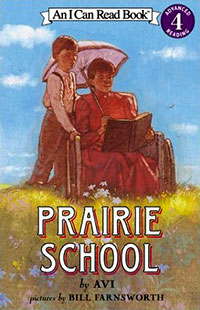 Other than my research there is no plan, no logic to my reading pleasure. I read what grabs my attention. So it was that I came upon a collection of reminiscences by folks from Nineteenth Century pioneer days, or at least homesteaders. I don’t know how the stories were gathered, but they were published, randomly, I believe, in newspapers. One of these tales concerned a young boy who lived on a prairie. He did not go to school and subsequently did not know how to read. But as he recalled he was taught to read by his visiting aunt, who was in a wheelchair. There was very little in the account, save that, but it caught my attention. Moreover the subject, age of the boy, and situation, struck me as something perfect for Harper’s I Can Read series.
Other than my research there is no plan, no logic to my reading pleasure. I read what grabs my attention. So it was that I came upon a collection of reminiscences by folks from Nineteenth Century pioneer days, or at least homesteaders. I don’t know how the stories were gathered, but they were published, randomly, I believe, in newspapers. One of these tales concerned a young boy who lived on a prairie. He did not go to school and subsequently did not know how to read. But as he recalled he was taught to read by his visiting aunt, who was in a wheelchair. There was very little in the account, save that, but it caught my attention. Moreover the subject, age of the boy, and situation, struck me as something perfect for Harper’s I Can Read series.
It all seems very simple, but it was very hard to write. The format demands economy, careful thought, and while you might think otherwise, a firm grasp of narrative structure. It is anything but a novel, but curiously, it has all the elements one wants in a vastly longer work setting, character, and plot.
Prairie School is a very small book, and indeed, a small story, but large in subject, and, as it turned out, large in emotion. From parents who have used it as bedtime read-a-louds, and teachers who have read it to new readers, it seems to engage young listeners in the whole notion, and enterprise of reading. Not a bad thing.
Bill Farnsworth did the evocative illustrations.
And since it is based on something, apparently, that really happened, I do wonder: whatever became of the real boy who learned to read?
1 thought on “Story Behind the Story #39: Prairie School”
Sounds like a much better introduction to reading than “Will Sal Meet Him?” On the other hand, it was such basal readers that drove me to read novels- and decide that I wanted to write them.